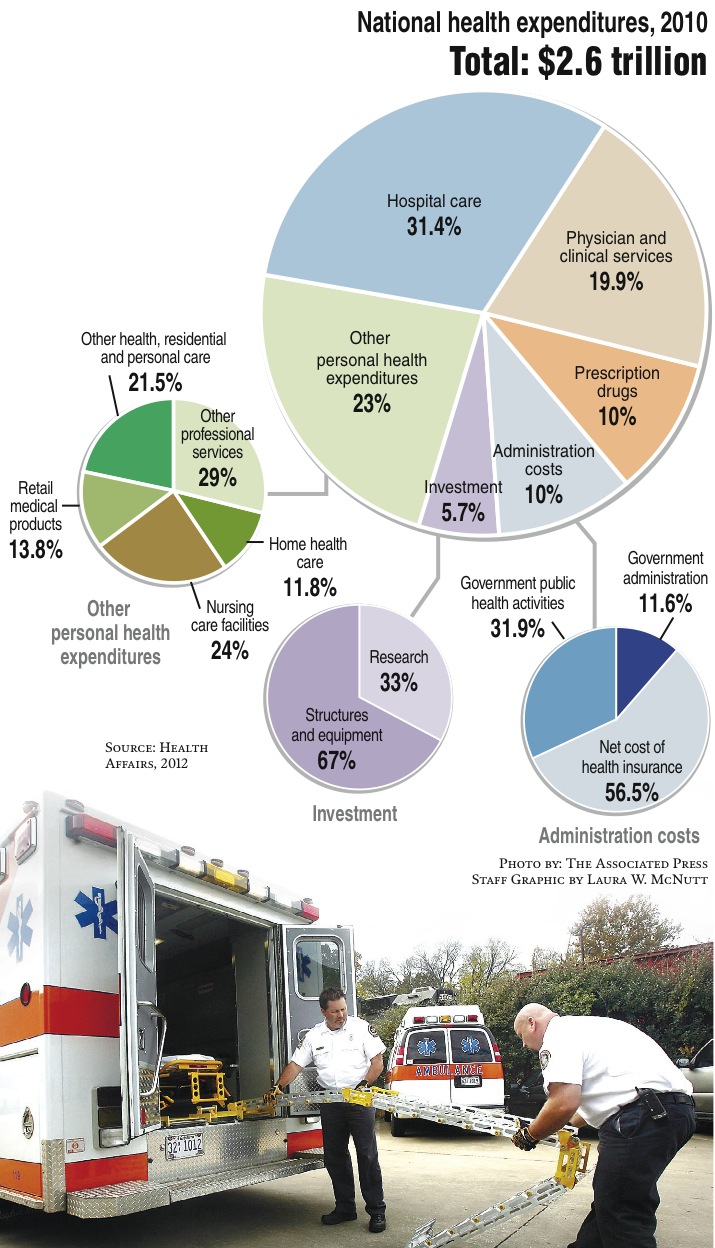Increasing dollar signs in health care can be found everywhere -- bigger hospitals bills, higher drug costs, a larger share of insurance premiums and more out-of-pocket costs.
The rate of increase slowed in 2010 -- at least partially because of consumers using fewer services -- but a recently released report shows the growth trend may have accelerated again in 2011.
The per capita cost of health care services grew more than three times the rate of overall inflation from July 2011 to June 2012, according to a study released Friday by HealthLeaders Media, a health information group.
Another study released this month shows large U.S. employers expect to see a 7 percent cost increase in health care benefits in 2013. Some of that will be passed along to employees, said the study, conducted by the National Business Group on Health.
The costs take a bigger share of the economic pie every year, but determining exactly what is the increase and how to slow the rate of growth are much more complicated than mere numbers, experts say.
"There is enough blame for everybody," said Alwyn Cassil, a spokeswoman for the nonpartisan Center for Studying Health System Change. "It's very complicated, and it's very difficult to get people to think about costs because health care is so personal. When it is your child and your loved one, the last thing you are thinking about is cost. You just want them to get better."
Health care costs recently took the forefront in a Chattanooga contract stalemate between Memorial Health Care System and BlueCross BlueShield of Tennessee. The contract between the two expired Aug. 1, with Memorial accusing BlueCross of not paying a fair market share and BlueCross saying it had to take a stand on double-digit cost increases.
UNIT PRICE
Several studies released earlier this year show most of the recent growth in health care costs has been in unit price -- the price of health care rather than an increase in usage or a change in the mix of services.
The Health Care Cost Institute, a nonpartisan group funded by insurers, conducted a first-ever study looking at 2009-10 data from private insurers for people under the age of 65. Most previous studies have primarily looked at Medicare data, said David Newman, executive director for the institute.
That study found the greatest rate of growth was in outpatient visits, which grew more than 10 percent, while inpatient admission costs grew just over 5 percent and outpatient procedures grew 1.7 percent. The rate of inflation was 1.6 percent during the same time period.
By comparison, average annual health insurance premiums grew 3.8 percent that year, according to information from the Kaiser Family Foundation.
Under current law, states must review and approve insurance premium increases of more than 10 percent. Hospitals do not have a similar requirement, but some states are looking at various options to hold providers more accountable.
The Tennessee Hospital Association declined to be interviewed to discuss rising hospital costs.
The Health Care Cost Institute study did not look at why costs continue to increase or what can be done to lower that rate of increase, Newman said. Some cost increases may not even be a bad thing, he said, noting that some of the fastest growth was in children's medical care.
"If the goal is to constrain costs or reduce costs, the first thing to know is where costs are going up faster," Newman said. "All we can do is point people to the information -- policymakers, payers, even providers -- to ask themselves what are we doing to drive down costs."
CONSUMER PRICE
The Health Care Cost Institute also found that, as health care costs rise, more of the cost is passed along to consumers. From 2009 to 2010, out-of-pocket costs for consumers increased more than 7 percent, the institute reported.
That's still a small part of the entire bill for health care, but consumers are feeling it, said Helen Darling, president of the National Business Group on Health.
"This is more of everybody's money, money out of your paycheck," Darling said. "It is money you don't have for house notes and car payments."
In a discussion on the Chattanooga Times Free Press Facebook page, local residents named doctors, hospitals and pharmacies as the primary reasons for cost increases. Several of them shared stories about high hospitals bills or expensive medications.
Insurance companies frequently get blamed for increases when they are only passing along the costs, said Roy Vaughn, vice president of corporate communications with BlueCross.
BlueCross said its average increase over five years is about 6.5 percent for renewing members, which is partially because of an increase in cost for each year as a member gets older, he said.
Rick Novack, president and general manager for Cigna in the Mid-South market, declined to release Cigna's average rate increases.
Officials with both BlueCross and Cigna said they recently have begun providing their members with more information about prices and cost of health care. Members can go to the insurers' websites and look up costs for certain procedures and compare that cost across various hospitals and other health care providers.
The hope is, as consumers see more of the costs, they may become increasingly savvy shoppers.
"They can make more informed decisions," Vaughn said.
In the end, the country has far too little intelligent discussion about how to change health care costs and far to much rhetoric and hyperbole, said Cassil. There is waste and inefficiency in every aspect of health care, she said. People don't make informed choices, and a fee-for-service model means doctors don't have incentives to decrease costs.
"We have to do a better job of getting more bang for our buck," Cassil said. "We're going to have to get serious about this."

